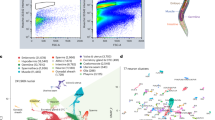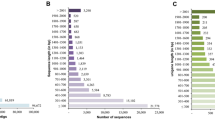Abstract
The silk gland of the silkworm Bombyx mori is a specialized organ where silk proteins are efficiently synthesized under precise regulation that largely determines the properties of silk fibers. To understand the genes involved in the regulation of silk protein synthesis, considerable research has focused on the transcripts expressed in silk glands; however, the complete transcriptome profile of this organ has yet to be elucidated. Here, we report a full-length silk gland transcriptome obtained by PacBio single-molecule long-read sequencing technology. In total, 11,697 non-redundant transcripts were identified in mixed samples of silk glands dissected from larvae at five developmental stages. When compared with the published reference, the full-length transcripts optimized the structures of 3002 known genes, and a total of 9061 novel transcripts with an average length of 2171 bp were detected. Among these, 1403 (15.5%) novel transcripts were computationally revealed to be lncRNAs, 8135 (89.8%) novel transcripts were annotated to different protein and nucleotide databases, and 5655 (62.4%) novel transcripts were predicted to have complete ORFs. Furthermore, we found 1867 alternative splicing events, 2529 alternative polyadenylation events, 784 fusion events and 6596 SSRs. This study provides a comprehensive set of reference transcripts and greatly revises and expands the available silkworm transcript data. In addition, these data will be very useful for studying the regulatory mechanisms of silk protein synthesis.






Similar content being viewed by others
References
Abdel-Ghany SE, Hamilton M, Jacobi JL, Ngam P, Devitt N, Schilkey F, Ben-Hur A, Reddy AS (2016) A survey of the sorghum transcriptome using single-molecule long reads. Nat Commun 7:11706
Altschul SF, Madden TL, Schäffer AA, Zhang J, Zhang Z, Miller W, Lipman DJ (1997) Gapped BLAST and PSI-BLAST: a new generation of protein database search programs. Nucleic Acids Res 25(17):3389–3402
Bede JC, Teal PE, Goodman WG, Tobe SS (2001) Biosynthetic pathway of insect juvenile hormone III in cell suspension cultures of the sedge Cyperusiria. Plant Physiol 127(2):584–593
Beier S, Thiel T, Münch T, Scholz U, Mascher M (2017) MISA-web: a web server for microsatellite prediction. Bioinformatics 33(16):2583–2585
Chang H, Cheng T, Wu Y, Hu W, Long R, Liu C, Zhao P, Xia Q (2015) Transcriptomic analysis of the anterior silk gland in the domestic silkworm (Bombyx mori)—insight into the mechanism of silk formation and spinning. PLoS ONE 10(9):e0139424
Chen J, Tang X, Ren C, Wei B, Wu Y, Wu Q, Pei J (2018) Full-length transcriptome sequences and the identification of putative genes for flavonoid biosynthesis in safflower. BMC Genom 19(1):548
Cheng B, Furtado A, Henry RJ (2017) Long-read sequencing of the coffee bean transcriptome reveals the diversity of full-length transcripts. Gigascience 6(11):1–13
Couble P, Michaille JJ, Garel A, Couble ML, Prudhomme JC (1987) Developmental switches of sericin mRNA splicing in individual cells of Bombyx mori silk gland. Dev Biol 124(2):431–440
Cui Y, Zhu Y, Lin Y, Chen L, Feng Q, Wang W, Xiang H (2018) New insight into the mechanism underlying the silk gland biological process by knocking out fibroin heavy chain in the silkworm. BMC Genom 19(1):215
Duan J, Li R, Cheng D, Fan W, Zha X, Cheng T, Wu Y, Wang J, Mita K, Xiang Z, Xia Q (2010) SilkDB v2.0: a platform for silkworm (Bombyx mori) genome biology. Nucleic Acids Res 38(Database issue):D453–D456
Fang SM, Hu BL, Zhou QZ, Yu QY, Zhang Z (2015) Comparative analysis of the silk gland transcriptomes between the domestic and wild silkworms. BMC Genom 16:60
Foissac S, Sammeth M (2007) ASTALAVISTA: dynamic and flexible analysis of alternative splicing events in custom gene datasets. Nucleic Acids Res 35(Web Server issue):W297–W299
Garel A, Deleage G, Prudhomme JC (1997) Structure and organization of the Bombyx mori sericin 1 gene and of the sericins 1 deduced from the sequence of the Ser 1B cDNA. Insect Biochem Mol Biol 27(5):469–477
Hu W, Chen Y, Lin Y, Xia Q (2019) Developmental and transcriptomic features characterize defects of silk gland growth and silk production in silkworm naked pupa mutant. Insect Biochem Mol Biol 111:103175
Katz Y, Wang ET, Airoldi EM, Burge CB (2010) Analysis and design of RNA sequencing experiments for identifying isoform regulation. Nat Methods 7(12):1009–1015
Katz Y, Wang ET, Silterra J, Schwartz S, Wong B, Thorvaldsdóttir H, Robinson JT, Mesirov JP, Airoldi EM, Burge CB (2015) Quantitative visualization of alternative exon expression from RNA-seq data. Bioinformatics 31(14):2400–2402
Korlach J, Bjornson KP, Chaudhuri BP, Cicero RL, Flusberg BA, Gray JJ, Holden D, Saxena R, Wegener J, Turner SW (2010) Real-time DNA sequencing from single polymerase molecules. Methods Enzymol 472:431–455
Kuo RI, Tseng E, Eory L, Paton IR, Archibald AL, Burt DW (2017) Normalized long read RNA sequencing in chicken reveals transcriptome complexity similar to human. BMC Genom 18(1):323
Li G, Li Y, Chen G, He J, Han Y, Wang X, Kaplan DL (2015) Silk-based biomaterials in biomedical textiles and fiber-based implants. Adv Healthc Mater 4(8):1134–1151
Ma L, Xu H, Zhu J, Ma S, Liu Y, Jiang RJ, Xia Q, Li S (2011) Ras1(CA) overexpression in the posterior silk gland improves silk yield. Cell Res 21(6):934–943
Ma L, Ma Q, Li X, Cheng L, Li K, Li S (2014) Transcriptomic analysis of differentially expressed genes in the Ras1(CA)-overexpressed and wildtype posterior silk glands. BMC Genom 15:182
Ma L, Li K, Guo Y, Sun X, Deng H, Li K, Feng Q, Li S (2018) Ras-Raf-MAPK signaling promotes nuclear localization of FOXA transcription factor SGF1 via Ser91 phosphorylation. Biochim Biophys Acta Mol Cell Res 1865(4):560–571
Meier P, Morris O, Broemer M (2015) Ubiquitin-mediated regulation of cell death, inflammation, and defense of homeostasis. Curr Top Dev Biol 114:209–239
Michael TP, VanBuren R (2015) Progress, challenges and the future of crop genomes. Curr Opin Plant Biol 24:71–81
Obara T, Suzuki Y (1988) Temporal and spatial control of silk gene transcription analyzed by nuclear run-on assays. Dev Biol 127(2):384–391
Omenetto FG, Kaplan DL (2010) New opportunities for an ancient material. Science 329(5991):528–531
Rhoads A, Au KF (2015) PacBio sequencing and its applications. Genom Proteom Bioinform 13(5):278–289
Royer C, Briolay J, Garel A, Brouilly P, Sasanuma S, Sasanuma M, Shimomura M, Keime C, Gandrillon O, Huang Y, Chavancy G, Mita K, Couble P (2011) Novel genes differentially expressed between posterior and median silk gland identified by SAGE-aided transcriptome analysis. Insect Biochem Mol Biol 41(2):118–124
Sharon D, Tilgner H, Grubert F, Snyder M (2013) A single-molecule long-read survey of the human transcriptome. Nat Biotechnol 31(11):1009–1014
Shen Y, Zhou Z, Wang Z, Li W, Fang C, Wu M, Ma Y, Liu T, Kong LA, Peng DL, Tian Z (2014) Global dissection of alternative splicing in paleopolyploid soybean. Plant Cell 26(3):996–1008
Shi R, Ma S, He T, Peng J, Zhang T, Chen X, Wang X, Chang J, Xia Q, Zhao P (2019) Deep insight into the transcriptome of the single silk gland of Bombyx mori. Int J Mol Sci 20(10):E2491
Simão FA, Waterhouse RM, Ioannidis P, Kriventseva EV, Zdobnov EM (2015) BUSCO: assessing genome assembly and annotation completeness with single-copy orthologs. Bioinformatics 31(19):3210–3212
Song J, Che J, You Z, Ye L, Li J, Zhang Y, Qian Q, Zhong B (2016) Phosphoproteomic analysis of the posterior silk gland of Bombyx mori provides novel insight into phosphorylation regulating the silk production. J Proteom 148:194–201
Suetsugu Y, Futahashi R, Kanamori H, Kadono-Okuda K, Sasanuma S, Narukawa J, Ajimura M, Jouraku A, Namiki N, Shimomura M, Sezutsu H, Osanai-Futahashi M, Suzuki MG, Daimon T, Shinoda T, Taniai K, Asaoka K, Niwa R, Kawaoka S, Katsuma S, Tamura T, Noda H, Kasahara M, Sugano S, Suzuki Y, Fujiwara H, Kataoka H, Arunkumar KP, Tomar A, Nagaraju J, Goldsmith MR, Feng Q, Xia Q, Yamamoto K, Shimada T, Mita K (2013) Large scale full-length cDNA sequencing reveals a unique genomic landscape in a lepidopteran model insect, Bombyx mori. G3 (Bethesda) 3(9):1481–1492
Takasu Y, Hata T, Uchino K, Zhang Q (2010) Identification of Ser2 proteins as major sericin components in the non-cocoon silk of Bombyx mori. Insect Biochem Mol Biol 40(4):339–344
Tomita M (2011) Transgenic silkworms that weave recombinant proteins into silk cocoons. Biotechnol Lett 33(4):645–654
Wang B, Tseng E, Regulski M, Clark TA, Hon T, Jiao Y, Lu Z, Olson A, Stein JC, Ware D (2016a) Unveiling the complexity of the maize transcriptome by single-molecule long-read sequencing. Nat Commun 7:11708
Wang S, You Z, Feng M, Che J, Zhang Y, Qian Q, Komatsu S, Zhong B (2016b) Analyses of the molecular mechanisms associated with silk production in silkworm by iTRAQ-based proteomics and RNA-sequencing-based transcriptomics. J Proteome Res 15(1):15–28
Wen M, Ng JHJ, Zhu F, Chionh YT, Chia WN, Mendenhall IH, Lee BP, Irving AT, Wang LF (2018) Exploring the genome and transcriptome of the cave nectar bat Eonycterisspelaea with PacBio long-read sequencing. Gigascience 7(10):giy116
Wu TD, Watanabe CK (2005) GMAP: a genomic mapping and alignment program for mRNA and EST sequences. Bioinformatics 21(9):1859–1875
Xia Q, Cheng D, Duan J, Wang G, Cheng T, Zha X, Liu C, Zhao P, Dai F, Zhang Z, He N, Zhang L, Xiang Z (2008) Microarray-based gene expression profiles in multiple tissues of the domesticated silkworm, Bombyx mori. Genome Biol 8(8):R162
Yi S, Zhou X, Li J, Zhang M, Luo S (2018) Full-length transcriptome of Misgurnus anguillicaudatus provides insights into evolution of genus Misgurnus. Sci Rep 8(1):11699
Zeng W, Liu R, Zhang T, Zuo W, Ou Y, Tang Y, Xu H (2017) BmYki is transcribed into four functional splicing isoforms in the silk glands of the silkworm Bombyx mori. Gene 646:39–46
Zhong BX, Yu YP, Xu YS, Yu H, Lu XM, Miao YG, Yang J, Xu H, Hu SN, Lou CF (2005) Analysis of ESTs and gene expression patterns of the posterior silk gland in the fifth instar larvae of silkworm Bombyx mori L. Sci China (C) 48(1):25–33
Acknowledgements
This work was supported by a grant (31872291) from the National Natural Science Foundation of China and a grant (cstc2017jcyjBX0041) from the Chongqing Research Program of Basic Research and Frontier Technology. American Journal Experts performed English language editing on this manuscript.
Author information
Authors and Affiliations
Contributions
All authors conceived and designed the experiments. TC, QS, YM and WZ performed the experiments and analyzed the data. LH, QS and HX wrote the manuscript. All authors read and approved the final manuscript.
Corresponding author
Ethics declarations
Conflict of interest
The authors declare no conflict of interest.
Ethical approval
This article does not contain any studies with human participants or animals performed by any of the authors
Additional information
Communicated by S. Hohmann.
Publisher's Note
Springer Nature remains neutral with regard to jurisdictional claims in published maps and institutional affiliations.
Electronic supplementary material
Below is the link to the electronic supplementary material.
438_2020_1691_MOESM1_ESM.tif
Supplementary file1 (TIF 2897 kb) Bioinformatics analysis process. (A) PacBio data processing pipeline. (B) Transcriptome analysis pipeline
438_2020_1691_MOESM2_ESM.tif
Supplementary file2 (TIF 410 kb) AS events in major silk gland TFs. Sashimi plot of ES and truncation events in the ASG, MMSG, PMSG and PSG. The RNA coverage is given as the log-transformed RPKM value, and junction reads are plotted as arcs whose width is proportional to the number of reads aligned to the junction spanning the exons connected by the arc. Genomic coordinates are shown on the x-axis. Quantified mRNA isoforms identified from the MergedSet are shown on bottom (exons in black, introns as lines with arrowheads)
Rights and permissions
About this article
Cite this article
Chen, T., Sun, Q., Ma, Y. et al. A transcriptome atlas of silkworm silk glands revealed by PacBio single-molecule long-read sequencing. Mol Genet Genomics 295, 1227–1237 (2020). https://doi.org/10.1007/s00438-020-01691-9
Received:
Accepted:
Published:
Issue Date:
DOI: https://doi.org/10.1007/s00438-020-01691-9




